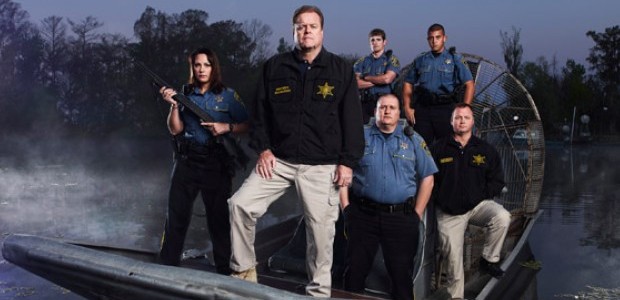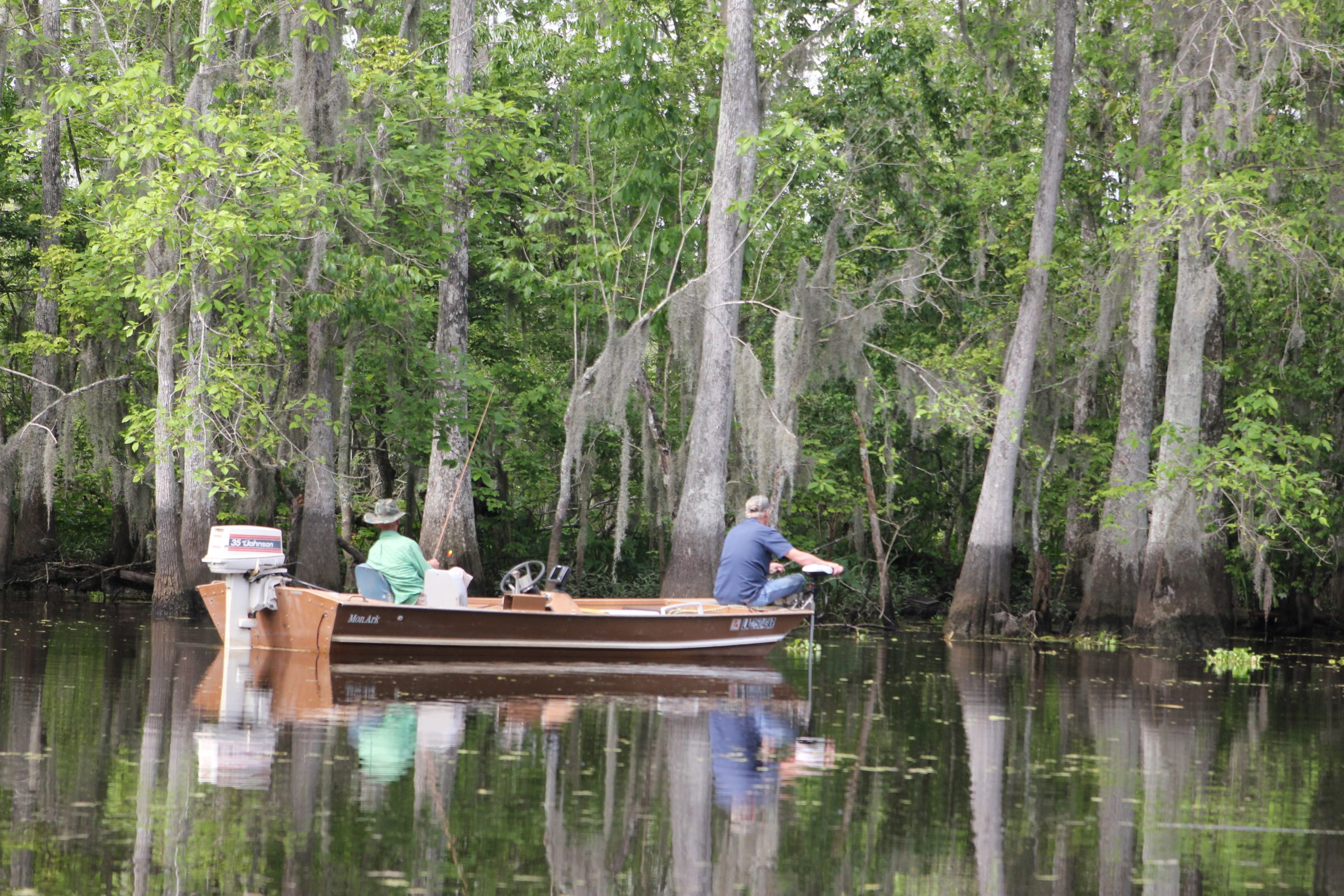
Peter Fournier
May 31, 2012
Mandalay refuge an environmental star in Terrebonne
June 5, 2012A signed agreement between MAK Pictures and the Terrebonne Parish Sheriff’s Office concerning film crews’ 24-hour access to document the office’s workings for broadcasting as the A&E television series “Cajun Justice” does not detail financial compensation to the sheriff’s office.
Terrebonne Sheriff Vernon Bourgeois said an agreement is in place that stipulates the office will receive $1,500 per aired episode.
“We did decide $1,500 an episode would be sufficient for the first year,” Bourgeois said.
“Cajun Justice” premieres at 9 p.m. tomorrow night. MAK Pictures is producing the reality-themed series, which A&E has green-lit for 21 episodes. The show takes viewers behind the scenes at TPSO and is said to follow deputies as they solve local crimes, a joint effort approved by Bourgeois.
The sheriff’s office forked over a $1,000 insurance deductible last year when a deputy wrecked a patrol car while filming a scene. At the time, neither party had signed the written agreement. This is the only sheriff’s offense expense related to “Cajun Justice” that has been recorded, Bourgeois said.
If A&E follows through on its announcement to air 21 episodes, the sheriff’s office would be in line to receive a lump sum of $32,500, which includes reimbursement of the insurance deductible, Bourgeois added.
On Monday, the Tri-Parish Times obtained a copy of the contract through a public records request. Mark Kadin, manager of MAK Pictures, signed the agreement on Jan. 6, 2011. Bourgeois signed on Dec. 27, 2011. At the time the contract was drafted, the show was named “Cajun Blue.”
Bourgeois could not be reached for a follow-up interview before press time.
The five-page contract outlines a multitude of formalities.
It includes granting production teams “exclusive access to, entry upon and use of” TPSO’s vehicles and office buildings. Neither the sheriff’s office nor any other party with interest in the office’s vehicles and office buildings can legally object to the use of filmed scenes for perpetuity, the contract states.
It stipulates that the sheriff’s office is covered under MAK Picture’s general liability insurance policy pertaining to “Cajun Justice.”
The agreement dictates that the sheriff’s office shall not modify the way it conducts arrests and bookings to satisfy television wants, such as staging a “perp walk” – when an arrestee is escorted into a jail or court house building – solely for the purpose of filming. Film crews can, however, film the actual perp walk.
The production company reserves “sole and absolute discretion over the creative content of the Program and each episode thereof (including, without limitation, themes, featured events, story line, timeline, and sequence of events), including the right to alter or edit the Materials in connection with or as part of the Program and the right to film re-enactments and/or pick-up scenes.”
Bourgeois, who has a contractual right to dispute any “factual accuracy” when reviewing “fine cut” episodes, insisted that most scenes were filmed live and re-creation was kept at a minimum. Fine cut versions are prepared prior to the broadcast edit of each episode, the contract says.
The one-term sheriff did not seek re-election last year and will vacate his office June 30.
Sheriff-elect Jerry Larpenter, who takes control of the office July 1, said he will discontinue filming despite receiving an offer of $10,000 per aired episode.
Larpenter was the parish’s sheriff for 22 years preceding Bourgeois before failing in a bid for parish president. Larpenter said he believes the $32,500 the office is said to receive this season does not cover the expenses.
“They’re filming every day,” Larpenter said. “They’re taking deputies on duty to go film. They’re using all of our equipment. Do you know how much they have to do to retake? Do you know how much fuel they have to use?”
A public-records request asking for receipts of expenses related to filming revealed nothing but a note referencing the insurance deductible. Bourgeois said minor expenses would be more than covered by the $1,500-per-episode agreement.
Producers occasionally stage certain elements of a story to keep the narrative in tact, which comes with minor expenses. Because the cost is negligible, TPSO has not kept records, Bourgeois said.
As an example of a staged scene, according to the sheriff, responding deputies have to be filmed receiving each complaint through dispatch. For water-themed scenes, producers want to see deputies launching a boat into the water, another task that is sometimes filmed after an incident is resolved.
“You’ve got to do that stuff because that was missed,” Bourgeois said. “A gallon of fuel in the boat and truck. Ten dollars. Two gallons of fuel.”
All other scenes are authentic and filmed by crews riding along with deputies, leaving no additional burden on the office’s resources, Bourgeois reasoned.
According to the contract, MAK Pictures is responsible “for all costs, supervision, production personnel, equipment and supplies associated with the production of the Program, except for such costs arising out of negligence or misconduct of TPSO, its agents or Personnel.”
Deputies are sometimes asked to supply supplemental time after work hours. Compensation for off-duty hours depends on an agreement between producers and featured deputies, the contract states.
The sheriff’s office charges producers the regular off-duty rate, the same rate charged for a deputy lending overnight security at a shipyard, and this responsibility comes at no cost to the office, Bourgeois said.
Regarding his decision, Larpenter also said profiling a select group of deputies might cause a “morale problem.” The incoming sheriff said that after seeing two full-length episodes and the show’s promotional materials, he believes producers are exploiting the sheriff’s department and local people for the sake of high ratings and the potential for millions of dollars in advertising revenue.
Filming of “Cajun Justice,” then called “Cajun Blue,” began in September 2011, according to Kadin. A&E announced speculative plans in April 2011. The contract continues until Bourgeois’ tenure as sheriff ends June 30.
“Even though it’s ‘Cajun Justice,’ I would almost characterize it as a character show over a law enforcement show,” Kadin said. “We’re really exploring the people and what makes up Cajun culture.
“It’s very visual. I think it’s more visual than most shows, like even more than ‘Swamp People,’ anything else that’s down there. We really try to make the bayou itself a character. There’s lots of talk about the bayous, the shrimping community and the people that work on the water.”
A promotional video posted on A&E’s website depicts Cajun Justice as an instance when local people shun police and take law enforcement into their own hands.
A woman pleads with an unseen deputy to bring an unseen person to her because “he needs Cajun Justice.” The video cuts to Cpl. Storm Fitch, one of the featured deputies who illuminates the premise while a rusted truck rots and a bayou runs in the background. A shotgun is used as background footage.
“And instead of calling us, they’ll try to take the law into their own hands, and most of the time it will end up into a gun fight,” Fitch says.
Other promotional videos show deputies responding to a graveyard robbery and a distress call concerning a sighting of a local 7-foot-tall hairy beast.
The cable network’s press releases maintain a similar theme, referring to the Terrebonne Parish Sheriff’s Office as a “world where the sheriff is like a king, voodoo is a common practice and no police call is routine.
“With the fiery personalities of the local Cajuns and the Louisiana justice system unlike any other (It’s the only state that is ruled under Napoleonic law), there’s no such thing as an ordinary police call. Whether it’s a creepy sighting of the Rougarou (“shape-shifting swamp monster”), a distressed neighbor reporting a stolen air condition during a heat wave, or a lead on a gruesome local serial-killer case; the deeper into the sticky swampland the deputies dive, the stranger and more mysterious the calls become.”
Kadin said the ultimate goal is to make the show unique to south Louisiana. Because they want to highlight certain aspects of the office, most of the footage will never be aired.
“Every case that we use (in the show), we try to have some sort of interesting thing about the case that makes it southern Louisiana, that makes it a Cajun case,” Kadin said. “There’s so many cases in the city there that are like any other cop show that you’ve seen. Basically, 90 percent of the stuff that we even shoot with the guys, we will never use because it just doesn’t fit what we’re trying to do with the show.”
Parish President Michel Claudet has seen two episodes, both of which he said he enjoyed and neither of which shamed the parish “in any way.”
“If there are other episodes that would portray Terrebonne Parish in a poor light, then certainly it would cause me concern,” Claudet added. “I’m just like the rest of the people in the parish; I haven’t seen it yet.”
Bourgeois said A&E’s press releases are “close” to being accurate; some embellishment is needed to better sell the show to a worldwide audience, he suggested. He added that descriptions and promotional videos that appear damning to the parish and its residents are only segments of a full 22-minute episode selected to grab potential viewers’ attention.
“They just want to get people fired up to watch Episode 1,” he said. “They want to intrigue people. They want people to watch.”
The show offers no benefit to the Terrebonne Parish Sheriff’s Office, Bourgeois said, but it will bring attention to the area’s “scenery,” coastal issues and alluring uniqueness, such as friendly, welcoming residents.
The sheriff said he consulted with other law enforcement agencies who have welcomed film crews into their midst and staff attorneys before green-lighting the show.
Bourgeois said that any scenes that could become lawsuits will not air. The sheriff has urged deputies not to speak with exaggerated accents, to avoid cursing and to always correctly quote laws on screen, so that the office doesn’t emit unbefitting behavior.
“Cajun Justice” could also correct some misconceptions about the region and its inhabitants, he added.
“I didn’t do it for the sheriff’s office; I did it for the area,” the sheriff said. “Because I do travel a lot, and still, even to this day, find that most people – because of other shows that are on TV, maybe – that everybody thinks we travel by boat, that we’re all people that didn’t finish sixth grade, that we’re all people who can’t read and write, that we go around barefoot everywhere, and we want to portray that that’s not true. Sure, there are some people that are like that. The whole nation, the whole world has people like that, but we shouldn’t be portrayed that way.”
The network will show two episodes per week, starting with tomorrow’s premiere. The first two episodes are titled “Bayou Busted” and “Catfish and Gators.”
“I think when people see the show, they won’t like 100 percent of it,” Bourgeois said. “I understand that. Who does, of any show? Even the most popular shows on the air, everybody doesn’t love.
“But I think the nation will really like the show. The nation will really see what we have and do here. They’ll see the riches that we have here, the good people that we have here, the law enforcement that we provide here at the Terrebonne Parish Sheriff’s Office and how professional they are.”
Terrebonne Parish Sheriff Vernon Bourgeois and a band of his deputies grace the A&E network tomorrow night for the premiere of “Cajun Justice,” a reality cop show that highlights south Louisiana culture and mannerisms.















